IB designs using Jayar 15 inch Venom drivers
An Infinite Baffle (IB) design is a sealed design where the box is infinitely large.
In reality, the box needs to be at least 10 times the combined Vas of the drivers.
The box is usually the roofspace, a space under the house, or an adjacent room such as a garage.
Since the drivers are not compressing air in a box or charging up a port, the transient response is excellent.
The unrestrained movement also means that it takes less power to reach excursion limits.
Since we're using less power and doing without any contribution from a port, more drivers will be needed.
All designs are modeled with a space of 10,000 litres. This is a bit larger than the minimum size for 4 drivers
( 150 * 4 * 10 = 6k ) and a bit smaller than the minimum size for 8 drivers ( 12k litres).
It's around half the 18k litres that a twelve driver design would like - increasing the modeled volume
just results in slightly less power being required than shown here.
Driver wiring options
Stereo solutions that produce a load less than two ohms per channel or greater than eight ohms per channel are ignored
Mono / Bridged mode solutions that produce a load less four ohms mono are ignored
When using pro amps, the stereo solution produces lower distortion than the bridged solution
The preferred solution is drawn in stronger colors. It's the one that provides sufficient power without stressing the amp
After the drawings is an analysis of what power would be available using the Behringer amps, and the preferred option is shown
IB4 - Four driver system
Requires 190w normal duty and up to 480w on peaks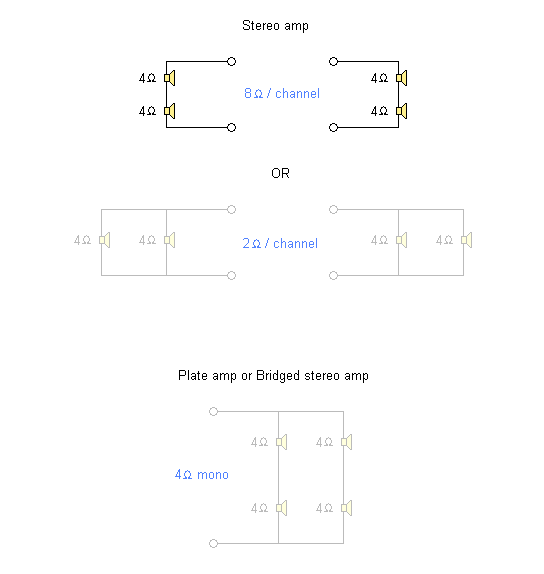
Behringer EP1500 amp
Stereo mode
2 ohms / channel gives around 1400w .... much more than is needed
8 ohms / channel gives around 560w ..... preferred option
Bridged mode
4 ohm load gives around 1400w. .... much more than is needed
IB8 - Eight driver system
Requires 410w normal duty and up to 1050w on peaks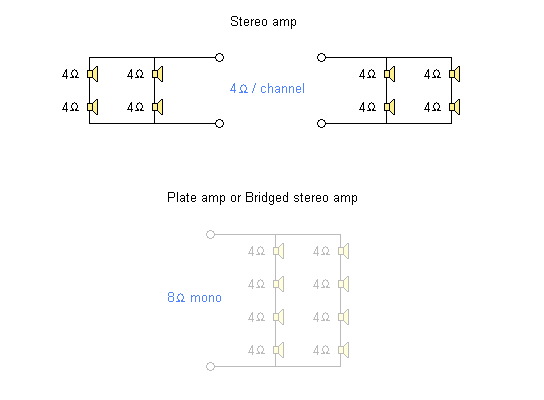
Behringer EP2500 amp
Stereo mode
4 ohms / channel gives around 1500w ( some reports say 1300w) ..... preferred option
Bridged mode
8 ohm load gives around 1500w ( some reports say 1300w)
Possible alternative amplifier
Behringer EP1500 amp
Stereo mode
4 ohms / channel gives around 560w ..... preferred option for this amp, but lacks headroom
Bridged mode
8 ohm load gives around 560w
IB12 - Twelve driver system
Requires 670w normal duty and up to 1700w on peaks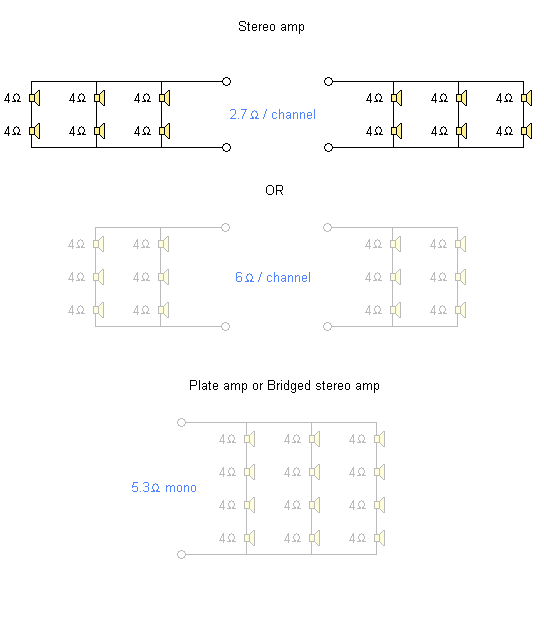
Behringer EP2500 amp
Stereo mode
2.7 ohms / channel should give around 1800w ..... preferred option
6 ohms / channel should give around 575w .... not enough power
Bridged mode
5.3 ohm load gives around 2000w
Chosen arrangements to model
| Sealed - IB4 | Four driver Infinite Baffle - 190w - Behringer EP1500 amp max 480w ....( 8 ohms / channel ) |
| Sealed - IB8 | Eight driver Infinite Baffle - 410w - Behringer EP2500 amp max 1050w ....( 4 ohms / channel ) |
| Sealed - IB12 | Twelve driver Infinite Baffle - 670w - Behringer EP2500 amp max 1700w ....( 2.7 ohms / channel ) |
SPL
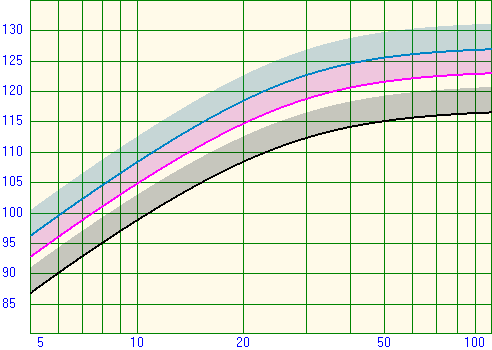
The shaded areas are for when excursion is allowed out to 20mm, which is the suggested Xlim. This will involve some distortion, but the drivers will be OK.
Cone excursion
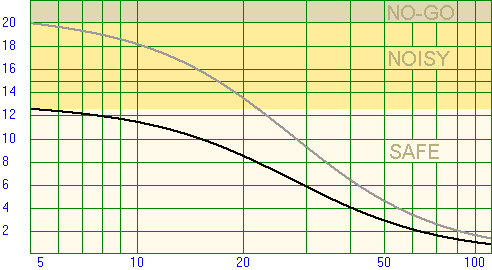
The black line is the resulting excursion for:
- a four driver design with 190w applied or
- an eight driver design with 410w applied or
- a twelve driver design with 670w applied
- a four driver design with 480w applied or
- an eight driver design with 1050w applied or
- a twelve driver design with 1700w applied
Displacement
When comparing IB systems, a common measurement is the amount of air displaced, which is worked out by the formula:
Displacement = Sd * Xmax * 2 * Number of drivers
...... where Xmax is the one-way value. The result is expressed in litres
| Displacement in litres at 25mm p-p | Displacement in litres at 40mm p-p |
|
| Four drivers | 7.5 | 12 |
| Eight drivers | 15 | 24 |
| Twelve drivers | 22.5 | 36 |
Suitability for horizontal mounting
When a driver is mounted horizontally, the cone will sag due to gravity. If the sag exceeds 5% of Xmax, then it is unsuitable.
According to a formula at Parts Express ......
Percentage of Sag = 24,849 / ( Xmax * Fsē) ...... where Xmax is the one-way value
This driver comes in at around 3% of our limit of 12.5mm, so it should be OK
Behringer Feedback destroyer
You may wish to buy a Behringer Feedback destroyer which allows you to even out the in-room response.
Peaks due to room nodes can be cut with up to 12 parametric equalisers.
You can also factor in a house curve for a tailored bass response.
The DSP1124P has been supeceded by the FBQ2496. Here's a comparison:
| DSP1124P | FBQ2496 |
| 12 parametric equalisers per channel | 20 parametric equalisers per channel |
| Can store 10 different sets of filters | Can store only one set of filters |
| Most likely will be v1.3 which has a MIDI port which won't talk to REW (see below). A small stock of units are v1.4 which has no problem |
No problem talking to REW |
| Better dynamic range | |
| Discontinued - may be hard to find | Available now |
If you go for the FBQ2496, don't confuse it with the DEQ2496, which is a crossover management device.
You can analyse your room using the free
Room EQ Wizard software written by John Mulcahy.
The software will even upload the new settings into the BFD via the MIDI port on your computer.
If your BFD is ver1.3, you'll need to enter the settings manually. If you have a BFD,
you can check it's version by holding in the Filter Select button during power up.
Mine turned out to be v1.3, so it was manual entry for me! Reading the values from REW meant that this was no big deal.
I've used the software to explore a couple of potential locations for an IB.
See my writeup here.
